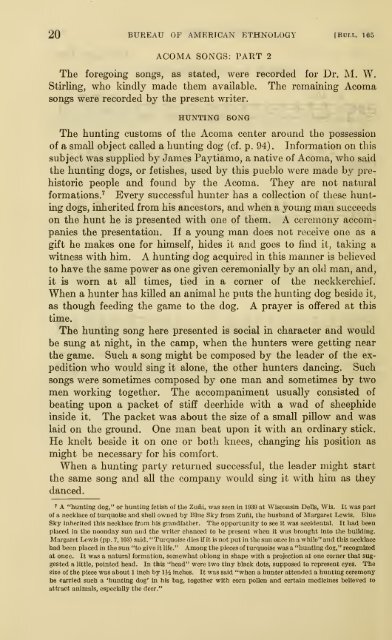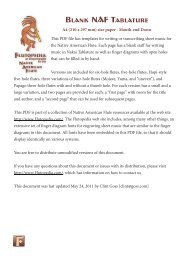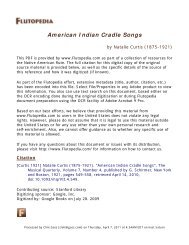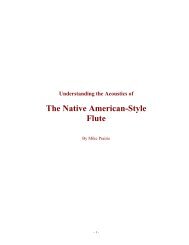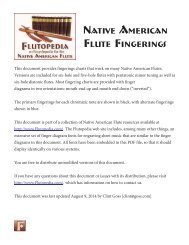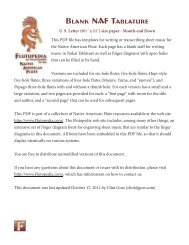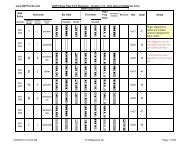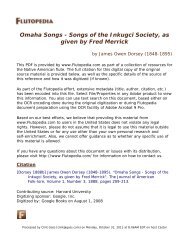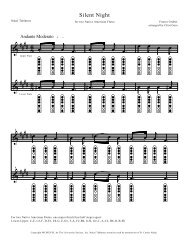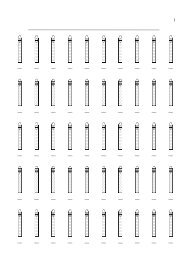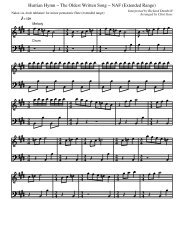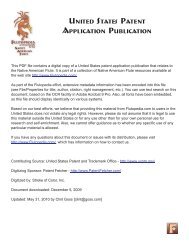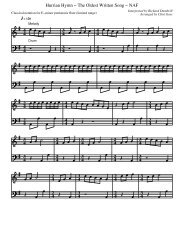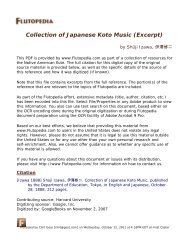Music of Acoma, Isleta, Cochiti, and Zuñi Pueblos - Flutopedia.com
Music of Acoma, Isleta, Cochiti, and Zuñi Pueblos - Flutopedia.com
Music of Acoma, Isleta, Cochiti, and Zuñi Pueblos - Flutopedia.com
You also want an ePaper? Increase the reach of your titles
YUMPU automatically turns print PDFs into web optimized ePapers that Google loves.
20 BUREAU OF AMERICAN ETHNOLOGY [Eut.t.. 165<br />
ACOMA SONGS: PART 2<br />
The foregoing songs, as stated, were recorded for Dr. M. W.<br />
Stirling, who kindly made them available. The remaining <strong>A<strong>com</strong>a</strong><br />
songs were recorded by the present writer.<br />
HUNTING<br />
SONG<br />
The hunting customs <strong>of</strong> the <strong>A<strong>com</strong>a</strong> center around the possession<br />
<strong>of</strong> a small object called a hunting dog (cf. p. 94). Information on this<br />
subject was supplied by James Paytiamo, a native <strong>of</strong> <strong>A<strong>com</strong>a</strong>, who said<br />
the hunting dogs, or fetishes, used by this pueblo were made by prehistoric<br />
people <strong>and</strong> found by the <strong>A<strong>com</strong>a</strong>. They are not natural<br />
formations.^ Every successful hunter has a collection <strong>of</strong> these hunting<br />
dogs, inherited from his ancestors, <strong>and</strong> when a young man succeeds<br />
on the hunt he is presented with one <strong>of</strong> them. A ceremony ac<strong>com</strong>panies<br />
the presentation. If a young man does not receive one as a<br />
gift he makes one for himself, hides it <strong>and</strong> goes to find it, taking a<br />
witness with him. A hunting dog acquired in this manner is believed<br />
to have the same power as one given ceremonially by an old man, <strong>and</strong>,<br />
it is worn at all times, tied in a corner <strong>of</strong> the neckkerchief.<br />
When a hunter has kiUed an animal he puts the huntmg dog beside it,<br />
as though feeding the game to the dog. A prayer is <strong>of</strong>fered at this<br />
time.<br />
The hunting song here presented is social in character <strong>and</strong> would<br />
be sung at night, in the camp, when the hunters were getting near<br />
the game. Such a song might be <strong>com</strong>posed by the leader <strong>of</strong> the expedition<br />
who would sing it alone, the other hunters dancing. Such<br />
songs were sometimes <strong>com</strong>posed by one man <strong>and</strong> sometimes by two<br />
men working together. The ac<strong>com</strong>paniment usually consisted <strong>of</strong><br />
beating upon a packet <strong>of</strong> stiff deerhide with a wad <strong>of</strong> sheephide<br />
inside it. The packet was about the size <strong>of</strong> a smaU pillow <strong>and</strong> was<br />
laid on the ground. One man beat upon it with an ordinary stick.<br />
He knelt beside it on one or both knees, changing his position as<br />
might be necessary for his <strong>com</strong>fort.<br />
When a huntmg party returned successful, the leader might start<br />
the same song <strong>and</strong> all the <strong>com</strong>pany would smg it with him as they<br />
danced.<br />
' A "hunting dog," or hunting fetish <strong>of</strong> the Zuni, was seen in 1939 at Wisconsin Dells, Wis. It was part<br />
<strong>of</strong> a necklace <strong>of</strong> turquoise <strong>and</strong> shell owned by Blue Sky from Zufii, the husb<strong>and</strong> <strong>of</strong> Margaret Lewis. Blue<br />
Sky Inherited this necklace from his gi-<strong>and</strong>father. The opportunity to see it was accidental. It had been<br />
placed in the noonday sun <strong>and</strong> the writer chanced to be present when It was brought into the building.<br />
Margaret Lewis (pp. 7, 103) said, "Turquoise dies if it is not put in the sun once in a while" <strong>and</strong> this necklace<br />
had been placed in the sun "to give it life." Among the pieces <strong>of</strong> turquoise was a "hunting dog," recognized<br />
at once. It was a natural formation, somewhat oblong in shape with a projection at one corner that suggested<br />
a little, pointed head. In this "head" were two tiny black dots, supposed to represent eyes. The<br />
size <strong>of</strong> the piece was about 1 inch by IJ^ inches. It was said "when a hunter attended a hunting ceremony<br />
he carried such a 'hunting dog' in his bag, together with corn pollen <strong>and</strong> certain medicines believed to<br />
attract animals, especially the deer."


